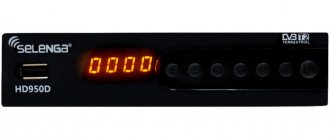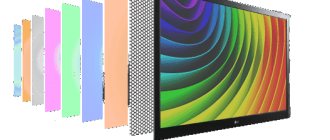The variety of TVs in recent years is simply amazing. One of the most important characteristics of monitors is their brightness and color rendition. So, in addition to the familiar abbreviation LED, today OLED and QLED are also presented. How are these concepts different?
In order to more accurately understand the difference, it is important to study in more detail the characteristics of each of them. You will need to highlight the advantages and disadvantages of monitors, as well as how differences between them can affect the quality of the transmitted image.
LED LCD what is it?
These types of monitors are quite common. They have a number of characteristics, and also have a variety of models, distinguished by monitor size. To understand their nuances, you should find out what the term LED LCD itself means.
So, LCD is understood as a panel that includes several sheets of a special material, between which a special solution is placed.
LED is one of the backlights for LCD panels, which is based on the activity of LEDs.
In other words, LED LCD is a liquid crystal monitor that has LED backlighting. As a result, the picture on such a screen is brighter and more saturated in quality.
Pros and cons of each type
The features, advantages and disadvantages of Edge LED or Direct LED technologies are directly related to the design of the TV and the characteristics of the formation of the light field for the TV's LCD matrix.
The advantages of the Direct LED backlight type include several main factors:
- a uniform light field for the entire area of the liquid crystal matrix, which is determined by the distributed nature of the arrangement of the LEDs;
- uniformity of luminescence implies a complete absence of glare;
- the placement of LED blocks on the back surface of the TV body increases its maintainability; The direct nature of LED emission determines lower energy consumption than options with end-mounted light sources.
Among the disadvantages of TVs with Direct LED technology, it is necessary to note the increased thickness of the television receiver housing and lower brightness than models with Edge LED.
Among the advantages of TVs with Edge LED backlighting, the following factors are worth noting:
- the total luminous flux of the LED block determines the increased brightness of the liquid crystal matrix, which has a positive effect on visual perception;
- side installation of backlight LEDs forms a thinner matrix of the screen and TV body (200 mm is considered to be the standard value for reducing thickness).
Among the disadvantages of thin television receivers with side-mounted LED technology, it is worth noting the high likelihood of glare and higher energy consumption compared to Direct LED.
OLED
This panel concentrates a large number of organic LEDs. Each cell of the panel has its own special light source, and their brightness is adjusted individually. As a result, there is no need to illuminate the panel. Therefore, if we talk about local dimming, which is available in LED LCD, then here you can observe local backlighting. With its help, it is easier and more effective to control the black level, as well as contrast.
4K OLED displays were first released in 2014 by LG. Years later, the presented panel could be found in the Panasonic, Sony, and Samsung brands.
The key differences between the panel include the following:
- Possessing high contrast;
- More uniform illumination. In case you want to darken the screen completely black, you will not find any white areas.
- Wide viewing angle.
- Short service life. It mainly varies around 6000 – 7000 hours. In other words, you will use this TV for about 2-4 years with moderate viewing.
- Subject to good maintainability.
How to choose a TV
To make the right choice, you must decide for yourself what you need from the device first and foremost, and what you could sacrifice. In order for you to imagine the result obtained, let’s consider the main differences between the image parameters and operation of LED and OLED TVs.
| LED TV | OLED TV |
| Color rendition | |
| LEDs have their own different colors, which create shades by enhancing or blocking the glow of one of them. On the other hand, due to the greater degree of research into this structure, many different technologies exist today that greatly expand the color spectrum and precision of crystal consistency. | The pixels, illuminated by organic LEDs, contain primary colors that are combined to produce the desired shade in each of them. |
| Black contrast and accuracy | |
| Due to the constant glow and sizes exceeding pixels, the LED backlight, even when blocked by crystals, still leaks through and does not make it possible to convey an absolutely black color. Because of this, the contrast also decreases - because instead of black, you see gray or even pale purple. | Here black is presented in all its depth and darkness, because by de-energizing an organic LED, you stop its glow so that there is no need to block anything. Because of this, the borders of the flowers look especially distinct. And nothing has ever surpassed OLED in this regard. |
| Brightness | |
| But in this regard, nothing can compete with LED TVs. Again, due to the same backlight, which cannot be completely dimmed. In addition, it illuminates the entire surface of the screen without exception. | Unfortunately, OLED TVs are not recommended to display brightness at full power. The fact is that, in addition to the shortened service life of blue LEDs, there is a dependence of the duration of operation of organic elements on the intensity of the glow: the brighter, the faster they burn out. That's why the UHD Alliance has adopted specific high dynamic range standards for OLED monitors. |
| View Range | |
| The glow, which is small but still comes through from the crystals, is especially noticeable when looking at the screen from the side. This noticeably distorts not only contrast, but also colors, so the viewing angle of LED displays is quite limited. | Let's start with the fact that many OLED monitors are curved. This alone makes it clear that no matter which side you sit on, you will see a fairly clear picture right in front of you. In addition, even on flat screens, no area darkens or changes color when the viewing angle changes. |
| Response time | |
| LED TVs have very good response times for their price. | Due to the fact that LEDs are connected to the pixels directly, without intermediaries, the light transmission speed is much higher than in LED matrices, so the picture changes faster, which means the response time is longer. In fact, it has been noticed that OLED displays really do not suffer from blur, which has a very beneficial effect on the condition of the eyes. |
| Energy costs | |
| The LEDs in LED monitors shine constantly, with the level of brightness set by the user. | Energy consumption depends not only on the brightness level, but also on the nature of the picture. When changing from a dark scene to a colorful summer landscape, the display begins to consume more power. |
| Dimensions | |
| The diagonal of LED TVs is becoming larger every year. You can afford to enjoy almost a cinema screen at home. | Due to the lack of an additional crystal grid, OLED TVs are much lighter and thinner than their rivals. And soon LG is already promising the release of a millimeter TV that can be rolled into a tube. However, the diagonal of such devices cannot be compared with LED technologies (at least not yet). Today, their largest size is 55″, but these models will still cost you more than any analogue with classic LEDs. |
| Purchase amount | |
| The price range for devices with LED monitors varies quite widely. Everyone can choose a model with a good price-quality ratio due to various diagonal parameters and the availability of additional features. | As mentioned above, any OLED TV costs three or even four times more than LED models. However, progress does not stand still; this technology is in the process of active development, which means that in 10 years such equipment will most likely cost much less. |
| Longevity | |
| The service life of LEDs is very long - up to 100,000 hours. If you turn on the TV for 10 hours a day, it will last you about 30 years. | It was already mentioned above that blue organic elements fail faster than red and green ones. The first ones will last for 30,000 hours, the others will work for several tens of thousands of hours more. Really, who would like an image that is completely devoid of blue? |
QLED
If you study this technology in detail, it differs in that the LEDs used are those that contain quantum dots. The term itself was developed by Samsung and is used as a corporate name for the latest monitors.
The essence of the work is that they took the main ordinary LED LCD display and placed a nano filter made of metal between it. With its help, it became possible to obtain high image brightness, as well as look at the screen with rich tones.
Features of LED TVs
LED literally stands for “light emitting diode”. Most modern models of such TVs are based on an LCD matrix. But unlike the predecessors of LCD TV CCFL as light sources , these devices use more modern and fade-resistant LEDs.
Despite all the differences and the use of different types of lighting, the operating principle of LED models is the same. Speaking about how they are arranged, you can visually imagine a large number of grilles equipped with various LEDs. Next, all the LEDs are passed through a special filter, and depending on the voltage of the electric current, they either become brighter or, on the contrary, the light is blocked. This design makes it possible to create a clear image in accordance with the specified settings. Repairing such lighting is a painstaking task, but it can be done with your own hands.
Depending on the cost of the model, different types of lighting are used:
- it can be located over the entire screen area - matrix (Direct LED), which improves image quality, but increases the thickness of the panel and power consumption;
- either on one, two sides or along the perimeter of the screen (Edge LED).
Speaking about the second option, it can be noted that the image quality is inferior to the first type, but, due to the location of the backlight, the thickness of such panels can be less than 1 centimeter, and they are also much cheaper and energy efficient. All the nuances of these TVs can be found in the article about choosing LED TV.
LED TV device with matrix backlight
Comparison of OLED, LED, QLED
And now, knowing the features and characteristics of each model, you can start comparing them. We will do this between LED and QLED from OLED.
Black noise level.
This characteristic is associated with the minimum glow of the monitor, while the level of white noise is at its maximum. The contrast value is usually considered as the ratio of black noise to white noise.
QLED. It features a VA panel but lacks local dimming features. As a result, contrast control is slightly lower than that of LED LCDs.
OLED. Although the entire image is not shown and cannot be completely darkened, the black level is absolute and the contrast is infinite.
LED LCD. It may show maximum contrast concentration values. True, its meaning is different and depends on the panel manufacturer.
OLED wins in this segment.
Response time
Objects moving across the screen will certainly leave traces. After all, the pixels that form the image try to dramatically change their shades. The shorter the response time, the smaller the footprint you get.
QLED. It is characterized by fairly fast switching (about 2 times), in comparison with the Samsung KS8000. The result is a cleaner image with less offset.
OLED. Due to the special nature of the light and shades from organic LEDs, the pixels are able to change color quite quickly, so the response time is minimal.
LED LCD. This value as a response time will depend on the TV model. If we consider a cheaper option, then there is a higher level of blur, in the more expensive segment it is less high.
OLED once again wins this category.
Viewing angle
QLED. Here we see an almost identical viewing angle to that of the Samsung KS8000. The only thing is that the breadth is not particularly rich, although the announcement said that it would be completely different.
OLED. Has a minimal viewing angle.
LED LCD. Not every monitor has the same viewing angle. True, some still have a good value in this category.
The category winner is OLED.
Volume of color
The indicator is distinguished by its novelty. Its value indicates how accurately the shade can be conveyed, which takes into account the concentration of the color gamut and brightness in three-dimensional space.
Please note that the color gamut allows you to characterize the largest number of shades that the monitor can display. Peak brightness represents the maximum brightness level of your screen. The wider the color gamut, the brighter the image you get. Therefore, the color volume is higher.
QLED. Such panels have multi-HDR. It is due to this that the brightness of color rendering is achieved in 5% color coverage. Due to the presence of a special certificate received from a well-known German company, the model with this panel has up to 100% accuracy in color reproduction. It is impossible to achieve such a result.
OLED. A large number of monitors have multi-HDR. Thanks to it, we get brighter and more realistic shades. As well as the depth of black, due to it the perception of brightness increases several times.
LED LCD. In such premium monitors, the manufacturer has introduced an HDR function. HDR delivers a rich color palette that reflects up to 95% of the entire color space. And also, with its help it is possible to obtain the most reliable color.
QLED wins this category.
What is the future for LCD and OLED?
Display manufacturers are doing their best to tweak and improve various LCD display limitations. OLED's goal is to become cheaper and brighter over the next few years, and we're seeing clearer developments in LCD displays.
Perhaps the most memorable is the “quantum dot”. This is a new way to approach LCD backlighting. Instead of using white LEDs, a quantum dot screen uses blue LEDs and "nanocrystals" of different sizes to convert light into different colors by changing its wavelength.
Samsung has been testing quantum dot technology for several years now, and the company's latest developments actually bring LCD (nicknamed QLED) closer to the performance of OLED. Samsung wrapped the nanocrystals in a metal alloy and retuned the lighting system, which eliminates many of the contrast and viewing angle issues associated with LCD panels.











